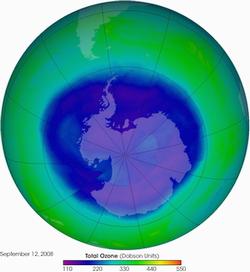 根據美國約翰霍普金斯大學(Johns Hopkins University)研究團隊所做的研究報告指出,越來越多的溫室氣體排放量可能會減緩地球上某些地區平流層臭氧的修復;因此科學家也提出警告,這樣可能會造成該些地區人民罹患皮膚癌的比例上升。
根據美國約翰霍普金斯大學(Johns Hopkins University)研究團隊所做的研究報告指出,越來越多的溫室氣體排放量可能會減緩地球上某些地區平流層臭氧的修復;因此科學家也提出警告,這樣可能會造成該些地區人民罹患皮膚癌的比例上升。
約翰霍普金斯大學地球暨行星科學系教授達倫沃夫(Darryn Waugh)及其同事於週四提出報告指出,氣候變遷可能導致熱帶地區以及中緯區(mid-latitudes)南部平流層下層的空氣循環產生變化。
空氣循環改變可能造成這些地區的臭氧層無法回流到下降之前的高度,甚至是在臭氧層破壞物質(ozone-depleting substances, ODS)從大氣層中消除之後情況還是一樣。
沃夫表示,在熱帶地區以及中緯區南部「全球暖化將會加速空氣被帶到或通往大氣層下層,由於空氣移轉的速度變快,因此不容易形成臭氧層。」
沃夫教授和美國太空總署(NASA)位於馬里蘭州綠帶市的戈德飛行中心(Goddard Space Flight Center)一起合作進行這個研究,而研究團隊藉由模擬的方式,也就是使用一種電腦模型即著名的『戈德地球觀測化學系統的氣候模型』,來預測臭氧修復的結果。
沃夫表示,這個研究將有助於科學家將臭氧層的變化引導到正確的研究模式。
他說,「臭氧會改變是因為對臭氧層破壞物質以及溫室氣體所做出的反應,如果不在研究臭氧修復資料中去思考氣候變遷的問題,事情會變得更混淆不清。」
這個研究發表於最新一期的『地球物理研究通訊』(Geophysical Research Letters)期刊當中,由美國地球物理聯盟所出版。
另外一名專精於大氣研究的科學家丹盧賓(Dan Lubin),亦針對臭氧消耗與地球紫外線(ultraviolet radiation)變化之間的關係進行許多相關的研究;他說沃夫的研究顯示,如果熱帶地區和中緯區南部的臭氧層無法回復到1960年代以前的水準,則可能會對住在這些地區的人民造成一些健康問題。
盧賓也指出,皮膚癌的威脅對於白種人,如居住在像澳洲、紐西蘭、智利、和阿根廷等國家的人們而言,在21世紀的威脅將比20世紀時來得更嚴重。盧賓是在位於加州拉荷雅的「斯克雷普斯海洋研究所」(Scripps Institution of Oceanography)進行了一些相關研究,但他並沒有參與沃夫教授的研究。
Increasing greenhouse gases could stall the recovery of stratospheric ozone in some regions of the Earth, according to new research by a team from Johns Hopkins University. The scientists warn that increased rates of skin cancer in those regions might result.
Darryn Waugh, a professor in the Department of Earth and Planetary Sciences at Johns Hopkins University, and his colleagues reported Thursday that climate change could provoke variations in the circulation of air in the lower stratosphere in tropical and southern mid-latitudes, including Australia and South America.
The circulation changes would cause ozone levels in these areas never to return to levels that were present before decline began, even after ozone-depleting substances have been wiped out from the atmosphere.
In tropical and southern mid-latitudes, Waugh says, "Global warming causes changes in the speed that the air is transported into and through the lower stratosphere. You're moving the air through it quicker, so less ozone gets formed."
Researchers at NASA Goddard Space Flight Center in Greenbelt, Maryland collaborated with Waugh in the study. The team forecast effects on ozone recovery by means of simulations using a computer model known as the Goddard Earth Observing System Chemistry - Climate Model.
Waugh says this research will help scientists attribute ozone variations to the right agent.
"Ozone is going to change in response to both ozone-depleting substances and greenhouse gases," he says, "If you don't consider climate change when studying the ozone recovery data, you may get pretty confused."
The research is published in the current issue of "Geophysical Research Letters," a publication of the American Geophysical Union.
Dan Lubin, an atmospheric scientist who has studied the relationship between ozone depletion and variations in the ultraviolet radiation that reaches the Earth, says Waugh's findings could cause health problems for people living in the tropics and southern mid-latitudes if ozone levels never return to pre-1960 levels in those regions.
"The risk of skin cancer for fair-skinned populations living in countries like Australia and New Zealand, and probably in Chile and Argentina too, will be greater in the 21st century than it was during the 20th century," says Lubin, who is at Scripps Institution of Oceanography in La Jolla, California and did not participate in the research.


